The
recent discussion of ball turret modifications brought to mind a series of "things on bombers" (e.g.
ejector chutes on PB-1W nose turrets,
venturi tube fume extractors on B-25s,
gun turret stabilizing fins) and from there something I had been meaning to post about for a while now: the Bombardier's Nose Access Window. (The name of the opening comes from a captioned image on
page N-24 of the
Maintenance Manual [for] B-25C and B-25D Airplanes. It is also called the "Nose Compartment Access Door" on
page 108 of T.O. 1B-25(T)J-4.)
About two years ago, I queried Dan Desko of the
B-25 History Project about it. At the time, I had been told that it was intended to allow the bombardier to clean the plexiglass in front of the Norden bombsight in flight, but I was a bit skeptical of that explanation. As it turned out, that was indeed correct, but some of the research I did in the process to determine the answer turned up some interesting information. For example, it was stenciled with instructions that the "DOOR MUST REMAIN LOCKED AT ALL TIMES IN FLIGHT":
Attachment:
 B-25 Bombardier's Nose Access Window Stencil.png [ 680.97 KiB | Viewed 962 times ]
B-25 Bombardier's Nose Access Window Stencil.png [ 680.97 KiB | Viewed 962 times ]
(Sources:
Library of Congress and
AirCorps Library)
This initially sent me on the wrong track, as how could a bombardier open the window if it was meant to remain locked at all times? Furthermore, the B-25 could be equipped with a windshield wiper and anti-icer spray tube anyway. On the other hand, I knew that certain aircraft had a small "
knockout window" on the lower left side of the windscreen. The B-25 even had a small removable
copilot window, which apparently existed for this purpose.
However, my working theory at the time was that it may have been intended as a way to pass instructions to the bombardier shortly before takeoff. I know that certain modern aircraft, such as the
ATR-75, have a small door on the side of the cockpit for this purpose. Although
originally designed for mail, the hamburger door on a C-47 could conceivably be used for the same thing.
Considering it includes extensive detail about interesting equipment on early B-25s that I was not even aware of, the approximately 1,300 page
Maintenance Manual [for] B-25C and B-25D Airplanes, I was surprised to learn that it does not mention the window. The pilot's manuals were similarly unhelpful as they are quite obviously for the pilot. I also skimmed through the
Bombardier's Information File, but didn't see anything there either.
However, it was their combat historian Mike Laney who set me straight by pointing out that it is described as "Door For Cleaning Bomb Sight Window" captioned image looking forward and to the right in the nose compartment on
page 65 of T.O. 01-60GB-1:
Attachment:
 Figure 37 - Bombardier's Compartment (Right Side).png [ 756.23 KiB | Viewed 962 times ]
Figure 37 - Bombardier's Compartment (Right Side).png [ 756.23 KiB | Viewed 962 times ]
(Source:
AirCorps Library)
(As an aside, the reason I had such trouble locating this information is that the view was deleted from later model B-25 handbooks. It is present in T. O. No. 01-60GB-1 for the C and D variants (officially titled
Pilot's Handbook of Flight Operating Instructions for B-25C and B-25D, not
Pilot's Manual for B-25 Mitchell as written on the cover of the reprint), but absent in AN 01-60GE-1 for the B-25J (
Pilot's Flight Operating Instructions). It should come after
page 64, as both versions have the forward and to the left view depicting the control boxes and that is the view immediately prior in the older handbook. It is also not present in the Pilot Training Manual for the B-25 Mitchell Bomber from 1944, where the forward and left view is drawn on
page 19, but not followed by the forward and right side view.) He also stated that it was his understanding that the windshield wiper was for the de-icing system and while effective in that role, it wasn't good enough that manual polishing of the window wasn't required.
(At this point, it may be worthwhile to digress a bit to cover the potential origins of "knockout windows". It occurred to me that airplanes of the era were designed by aviators who were used to open cockpit airplanes. So providing for the ability to easily access the outside of the aircraft if there was a problem would have been only natural for them. I once read an academic paper about how the history of the development of the automobile was all about isolating the driver more and more from the road and the act of driving and how it made each generation see the next as not being "true" drivers. It's the same sentiment that leads to jokes about kids not knowing how to drive stick shift or, if you go back further, use hand signals, or even further hand crank their own car. One of the major changes that it noted was enclosing the passenger compartment of the car. According to earlier drivers, how was a driver supposed to know how to race if he couldn't feel the wind? I think the same opinion applied to airplanes and that's what might got us "knockout windows" and the bombardier's nose access window.)
Now, the
Pilot's Handbook of Flight Operating Instructions: Navy Model PBY-5A Airplanes has a note that reads:
Pilot's Handbook of Flight Operating Instructions: Navy Model PBY-5A Airplanes wrote:
A handhole, with a cover removable on the in-
side, is located immediately to the right of the sighting
window in the nose of the airplane. The handhole per-
mits the bomber [sic] to clean the outside of the window
during flight.
(Source:
Pilot’s Handbook of Flight Operating Instructions Navy Model PBY-5A Airplanes, AN 01-5MA-1, 1 August 1945, 88.)
What's more, in addition to the handhole, the PBY also had a roll up window, not unlike that of the B-24 bomb bay doors, that covered the sighting window:

(Source:
Wikimedia Commons)
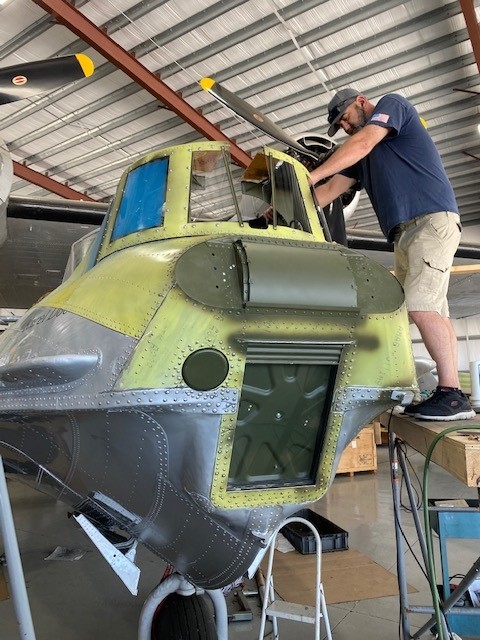
(Source:
American Heritage Museum)
There was also apparently an internal hatch as well that could be dogged for watertightness...
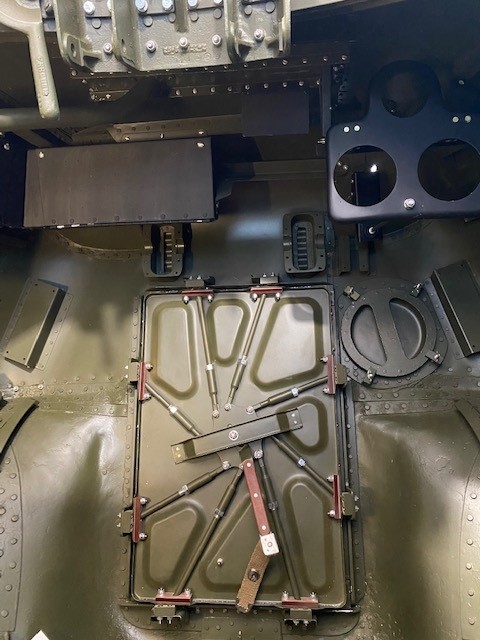
(Source:
American Heritage Museum)
...which also came in a different shape on later aircraft:
Attachment:
 PBY-5A Bombardier Window Hatch.png [ 593.03 KiB | Viewed 962 times ]
PBY-5A Bombardier Window Hatch.png [ 593.03 KiB | Viewed 962 times ]
(Source:
YouTube)
The Navy, possibly as a result of dealing with things sea spray, was particularly keen on the subject. Doors for what was presumably a similar purpose to the shutter were seen on the RC-45J...
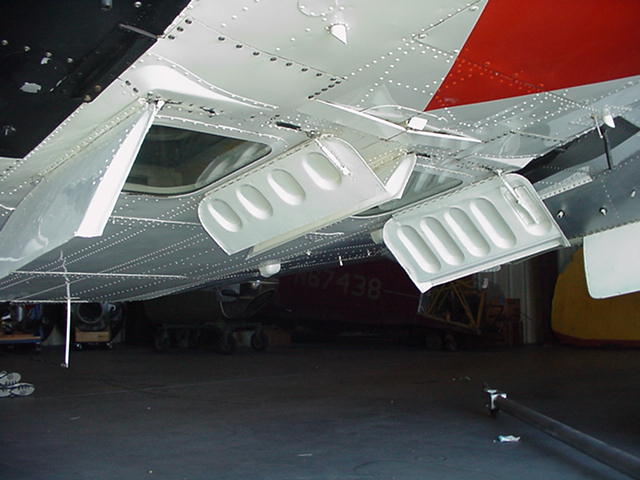
(Source:
TwinBeech.com)
...and the TBD (or at least the prototype) featured a hinged window:
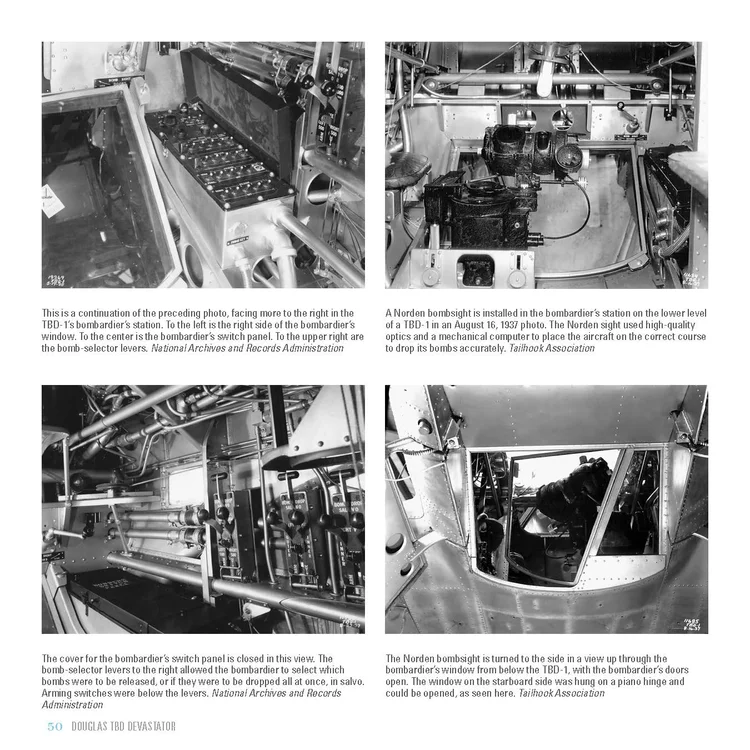
(Source:
David Doyle Books)
Meanwhile, the sighting window in the TBF/TBM did not require protection as it was located inside the bomb bay and therefore protected by the bomb bay doors when closed:

(Source:
Tailhook Topics)
Whenever this subject comes up, it makes me think of the CANT Z.1007. The Italians had such a fascination with tri-motors, but since the bombardier's position was located immediately behind the #2 engine, it seems that one of the downsides to the configuration would be that it would be splashed with oil:
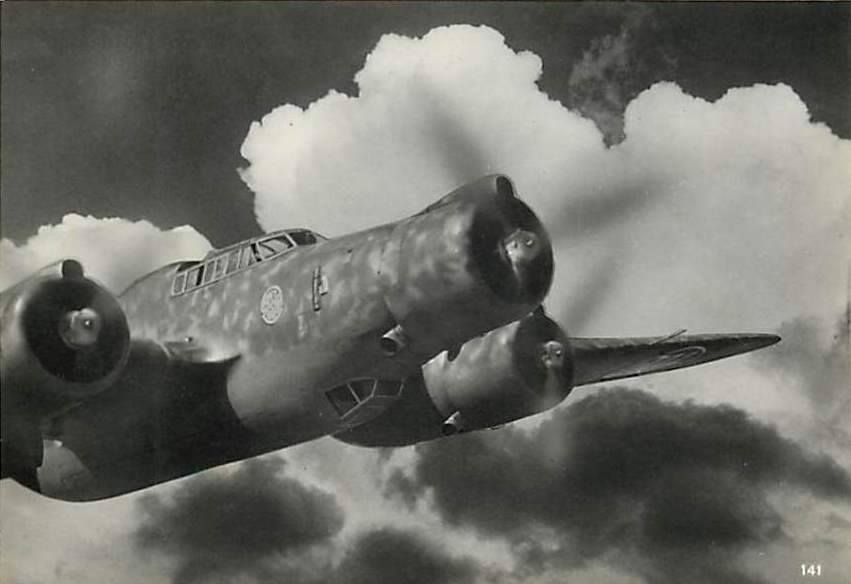
(Source:
Aviation Rapture)
This certainly happened with another liquid substance, as repeated by Ken Wright in an excellent article called "And When Nature Calls" from the Bomber Command Museum of Canada:
Bill Frankhouser wrote:
Another necessary caution on urination was to warn the ball turret gunner if the relief tube was to be used. The stream of urine from this tube impacted onto his turret while flowing in the air stream. At high altitudes, it froze as a yellow cloud on his turret. The instruction was to warn him about your intention so that he could turn his view screen away from the relief tube. When not warned, his guns were useless since he had no visibility until the yellow cloud melted at lower altitudes. Often, forgetful urinators were cursed roundly by the ball turret gunners.
(Source:
Bomber Command Museum of Canada)
So I hope this little narrative is informative, because I certainly learned a bit in during the research process.





